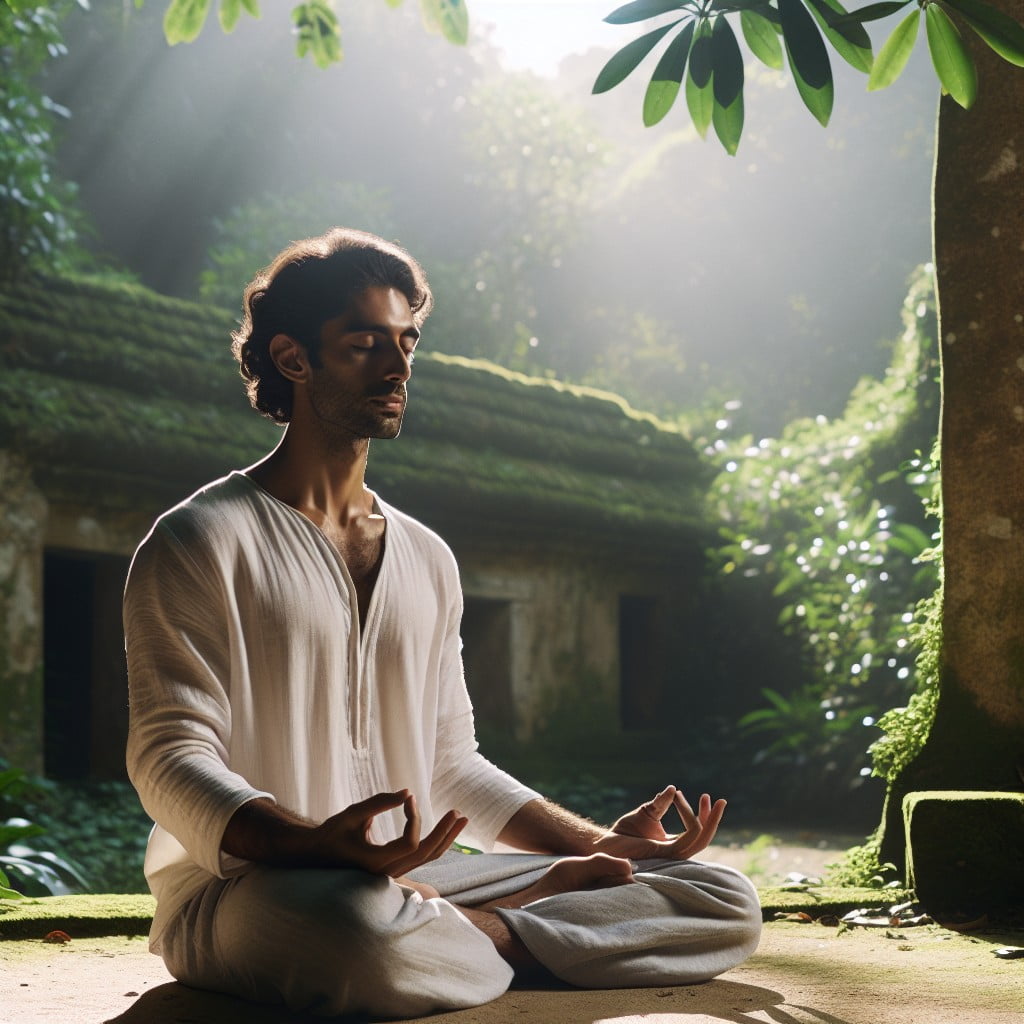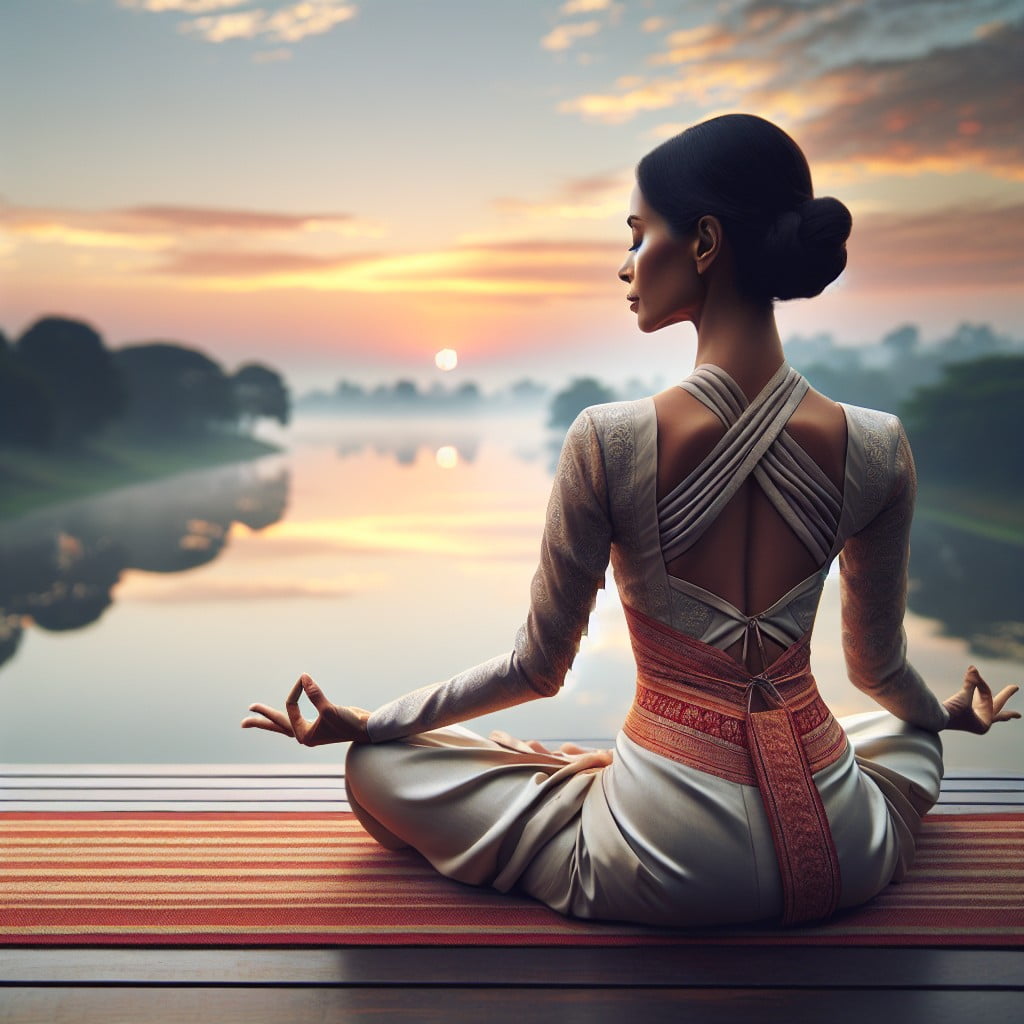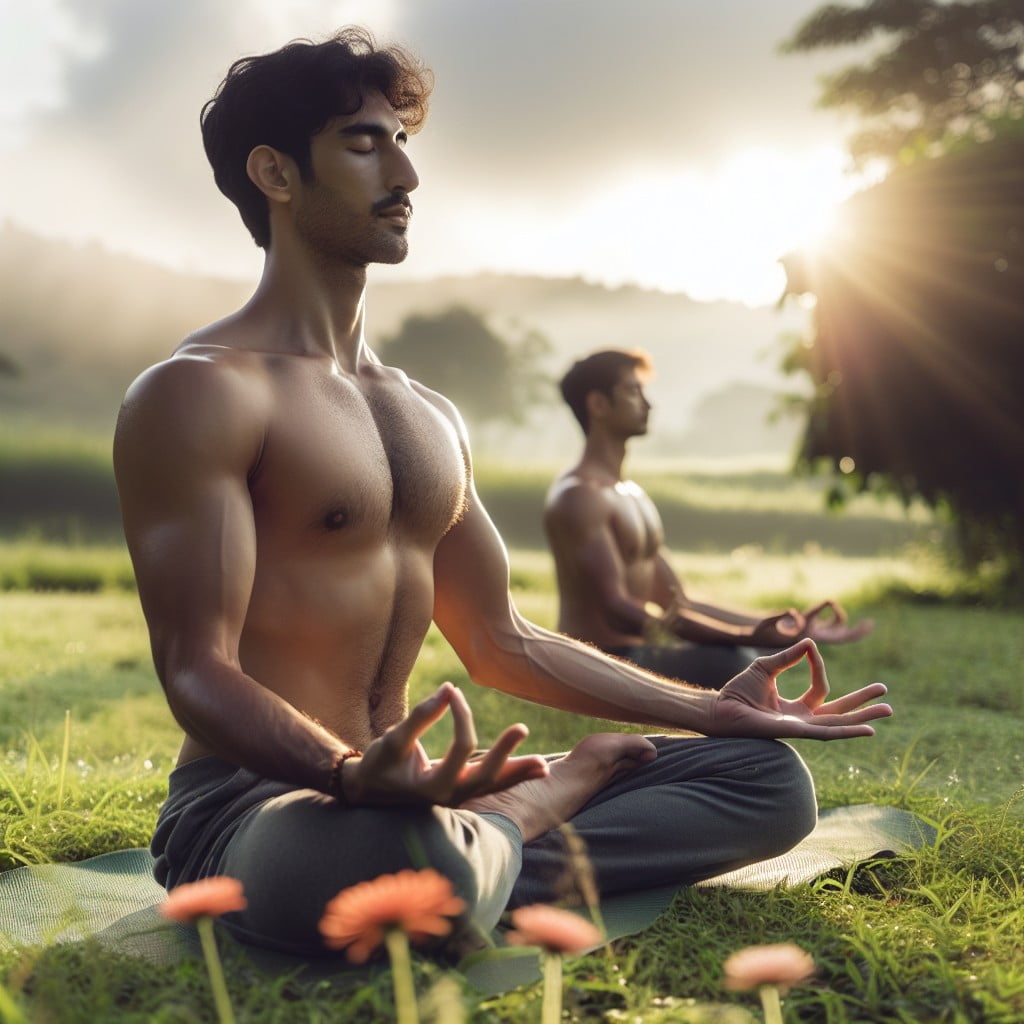Unlock the profound benefits of tranquility through meditation, because a calm mind can open the gateway to an extraordinary life, much like a yogi’s.
Embarking on the journey to meditate like a yogi requires understanding and adopting certain practices that yogis have been using for centuries. This involves creating a serene environment, using specific meditation techniques, and embracing a yogic mindset.
In this article, you’ll discover the step-by-step process to meditate like a yogi, learn about the importance of breath control, and get tips on how to maintain focus during your sessions.
Let’s dive into the world of yogic meditation, where peace and mindfulness are only a breath away.
Key takeaways:
- Create a serene meditation space free from distractions and clutter.
- Use specific meditation techniques like breath control, mantras, and visualization.
- Maintain a correct posture with an erect spine for optimal results.
- Learn from the teachings of famous yogi Paramahansa Yogananda.
- Develop a consistent meditation routine with short sessions and daily rituals.
Preparing a Space for Meditation

Creating an environment conducive for meditation is of significant habit for a yogi, given its effect on achieving focus and tranquility. A seeker should ideally have a quiet, clean, and well-ventilated room designated for this purpose. Consider using low lighting or natural light to enhance the calming effect.
Elements of nature, such as plants or a view of a garden, can also bring about a sense of tranquility. Cultivating a minimalistic setup, free from clutter and distractions, helps in maintaining focus.
Personalizing the space with elements like a meditation mat, cushion, blanket, and even candles or incense, is beneficial. These enhance comfort and foster deeper connections with the practice. Please remember, the sense of comfort shouldn’t lead to slouching or losing the posture.
Avoid using digital devices in the meditation space as they are a source of distraction. The goal is to disconnect from the outside world and connect inward.
The energy of the space utilized for meditation holds significance too. It is believed that meditating in the same spot amplifies positive vibrations, making it easier to transition into a meditative state. Therefore, respect and care for the space are essential, building it up as a sanctuary for inner exploration.
As you gradually build your meditation space, remember that perfection isn’t the goal. It’s about creating a personal retreat, a serene environment that supports your journey into mindfulness and inner peace.
Understanding Meditation Techniques of a Yogi

First, it’s key to comprehend that yogi meditation techniques place a strong emphasis on connecting the body with the mind and spirit.
1. Focus on Breath: Begin with observing one’s own breath. Not controlling, simply paying attention to the natural process of breathing in and out. In time, this calms the mind and increases awareness.
2. Mantras: A mantra is a word or phrase that is repeated during meditation. It’s a focal point that helps quiet the mind. You may choose a traditional Sanskrit phrase like “Om,” or any positive affirmation that resonates with you.
3. Visualisation: A useful tool to achieve mental clarity. This involves picturing and focusing on soothing and peaceful scenarios like a tranquil lake or a green forest.
4. Body Scan: This involves taking mental notice of each body part, making a conscious effort to relax any tenseness found. It encourages a mind-body connection.
5. Mindful Meditation: This simply involves being aware and accepting of your current thoughts, emotions, and surroundings without judgement or interpretation.
Remember, no single technique is superior or inferior, it’s about identifying what aligns best with your goals and lifestyle. Find what resonates with you.
Correct Posture for Yogi Meditation

Maintaining proper posture is essential in achieving the best results from meditation. The body should be comfortable and relaxed, yet alert, which allows for optimal energy flow. The essential elements for a correct posture encompass a few points:
- 1. Sit on the forward edge of a cushion or blanket. This helps to align the spine and encourages its natural curvature.
- 2. Allow your knees to be lower than your hips. This helps prevent strain in lower back and hips. Use additional props under the knees for support if needed.
- 3. Keep your shoulders back and your chest open, which allows for improved respiration.
- 4. Neck should be long, chin slightly down and in – imagine a string pulling the crown of your head upwards.
- 5. Your hands can rest comfortably on your lap or knees. Remember, comfort is key. You don’t want to be distracted by physical discomfort during your meditation.
This posture keeps your body active and allows each breath to flow with ease. Note that there should not be any force or strain necessary to maintain this posture. If you feel any discomfort, adjust your position until you feel more at ease.
Importance of an Erect Spine in Yogi Meditation

Having an erect spine is integral to yogic meditation. This posture aligns the vertebrae accurately, boosting the practitioner’s comfort and endurance during longer periods. With the spine upright, energy can flow freely along the spinal cord.
- Balanced Energy Pathways: The upright position ensures energy known as Prana in Yogic philosophy, circulates smoothly along the spine. This flow contributes to a balanced and invigorating meditation.
- Physical Benefits: Regular practice of this posture can alleviate back pain and improve body posture over time. This position strengthens the spinal cord and enhances physical stability.
- Enhanced Focus & Concentration: The erect position aids in maintaining alertness while reducing fatigue or drowsiness.
Remember, while the erect posture is essential, comfort should not be compromised. Each person’s body is unique. Therefore, find the seating arrangement and props that will help you maintain an upright posture without discomfort.
Guidelines for Yogi Meditation Seating
Comfort is vital to facilitate a serene meditation experience. Initially, try different seating postures and select what best suits your body. Cross-legged seating, akin to the lotus position, is often preferred by experienced practitioners for its stability and grounding effect. However, senses of discomfort should never be disregarded in the pursuit of this idealized image.
If mobility is an issue, meditation can successfully be practiced sitting on a chair, with feet firmly grounded. Use cushions or blankets to support your knees or lower back if needed.
Remember, the aim is to maintain an erect yet relaxed posture. This encourages an open chest and facilitates the natural flow of breath, fostering a deeper connection between the mind and body. Experiment with arrangements and materials around you until you discover what works best for you.
Also, do not underestimate the power of consistency. Dedicate a specific location in your home for meditation, equipped with your seating setup. This fosters a conditioned mental reflex, signaling your mind to naturally transition to a state of calm and focus each time you sit in the chosen spot.
Learning From the Writings of Famous Yogi Paramahansa Yogananda
Paramahansa Yogananda, a renowned yogi, has provided valuable insights on meditation in his book “Autobiography of a Yogi”. Let’s traverse some of these teachings:
1. Meditation as a Daily Routine: Yogananda emphasized making meditation a regular practice. He believed daily meditation, especially at dawn and dusk, could lead to spiritual growth and tranquility.
2. High Emphasis on Concentration: Yogananda suggested focusing on a specific idea or image, like a spiritual symbol or deity, to enhance concentration during meditation.
3. Use of Kriya Yoga Techniques: Yogananda propagated Kriya yoga, where specific breathing techniques are used in synchrony with mental concentration. This method aims to control the energy flow within the body.
4. Balance between Activity and Meditation: Lastly, Yogananda advocated for correlating meditation with an active life. This balance ensures mindfulness seeps into daily activities, and not confined solely to the meditation routine.
Developing a Yogi Meditation Routine
To form a routine, start with short sessions. Five minutes a day can instill a habit. Slowly extend this time as your focus strengthens. Consistency is key. Choose the same time daily when your mind is alert yet relaxed. Morning, just after waking or evening before bed can work well.
Daily rituals enhance the experience. Light a candle or incense. These sensory cues evoke a meditative mindset, signaling your brain it’s time to quieten the chatter.
Select a focus. Yogi meditation often harnesses mantras or breath work. A mantra, a word or phrase repeated during meditation, needs to be positive and present-tense. If you prefer focusing on breath, notice its rhythmic flow, without trying to change it.
Remember, the goal is not to suppress your thoughts; it’s to observe them without judgement. They are like clouds passing across the sky—notice them, then gently return your focus back to your mantra or breath.
Lastly, end with gratitude. A simple acknowledgement of something you’re grateful for will help emerge from your practice with a subtle uplift in mood.
FAQ
How do yogis meditate?
Yogis meditate typically in a comfortable position, usually either in the lotus posture or a simple cross-legged position, ensuring that the body is at ease to maintain focus on the meditation and not on any bodily discomfort.
How many hours do yogis meditate?
Yogis typically meditate for at least 40 minutes daily, however, exceptional instances like monks can devote up to 16 hours a day to meditation.
How do I know if I'm meditating correctly?
You'll know you're meditating correctly when your reactions to thoughts diminish while your overall awareness of your environment, including subtle sounds and smells, increases.
What is the Himalayan meditation method?
The Himalayan meditation method is a practice that centers on connecting with one's true self and the supreme being through sitting meditations and mindfulness exercises, targeting enlightenment and present-moment awareness.
What type of meditation do Yogis practice most commonly?
Yogis most commonly practice mindfulness meditation, focusing on the present moment while calmly acknowledging and accepting feelings, thoughts, and bodily sensations.
How can certain physical postures enhance the effectiveness of Yogic meditation?
Certain physical postures, such as the lotus or half-lotus, can enhance the effectiveness of Yogic meditation by facilitating easeful breathing, promoting spinal alignment, and fostering a sense of stability and groundedness.
Are there specific breath control techniques Yogis use during meditation?
Yes, Yogis commonly use a breath control technique during meditation known as "Pranayama" where they focus on controlling their breathing by inhaling, holding their breath, and exhaling in measured patterns.